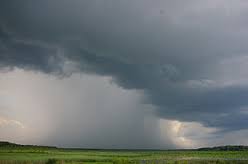How Australia’s first weather chart predicted a hunger for forecasts

The understanding of matters meteorological was so rudimentary in the early decades of the colonies that until at least 1855, people thought weather systems moved from east to the west.
“[People believed] all weather changes were experienced first on the east coast, next at Melbourne, then at Adelaide, and we may suppose that those who troubled any further about the matter would add, finally at Perth,” said Ernest Cooke, the WA Government Astronomer in the 19th century, according to David Day’s book The Weather Watchers.
The spread of the telegram would confirm the opposite to be true, particularly when Adelaide and Perth were linked in 1877.
That year, Henry Russell, the long-time NSW government astronomer and part-time meteorologist, also created the first weather map to be published in an Australian newspaper, running in the Sydney Morning Herald 140 years ago, this Monday.

Nestled on page six amid the “Melbourne Live Stock Market” report (“unsatisfactory as butchers had full stocks”) and ads for music “chosen to meet the advanced musical taste of this colony”, the weather map for two days earlier said Sydney at 9am in the shade was a mild of 67 degrees Fahrenheit (19 Celsius) with a rising barometer reading.
But more interesting would have been the effort to decipher “the probable position of the barometric depression”, marked as a big low centred west of Brisbane that may at least have hinted at weather to come. (See chart below.)

The sketch would have carried more certainty but it was based only on observations telegraphed in from “about 40” sites across the NSW and Victorian colonies. It would be years before Queensland dropped its refusal to share its weather reports with other colonies, Day notes in his book.
Blair Trewin, senior climatologist at the Bureau of Meteorology, says early readings were restricted to land and it would take decades for ship observations to be readily transmitted.
Even so, public interest soared.
“Certainly by the 1890s, you start to see weather charts appearing regularly,” Dr Trewin said.
‘Explosive temper’
Early efforts were often led by energetic characters such as Queenslander Clement Wragge, known for his “mop of flaming red hair and explosive temper to match”.
Day notes Wragge came up with the novel idea of naming low-pressure systems that came out of the southern ocean, bringing storms and rain.
“There’s a certain amount of legend around that he named them after politicians he didn’t like, and when they objected, he started naming them after their wifes,” Dr Trewin said.
The practice ceased when Wragge missed out on having any chance of becoming the first director of the new Bureau of Meteorology of the newly federated nation in 1908, and left Australia in a huff. It was not until 1963, naming of cyclones resumed.
The arrival of radio, computing and satellites transformed the humble weather map into today’s far more reliable, even dynamic service. Some 88 per cent of maximum temperature next-day forecasts are now accurate to within 2 degrees, up from 83 per cent a decade earlier.
“Seven-day forecasts are now as accurate as four-day ones 10 years ago,” Andrew Tupper, head of the bureau’s national operations, said.
Super-computers allow model runs to be done at much smaller scale. Today, for instance, they would enable forecasting at the level of major sports venues spread across a city, a service that was not available at the time of the Sydney Olympics, Dr Tupper said.
Predictions for extreme weather events, such as cyclones or the altered conditions major bushfires can generate, are other areas of consistent improvement.
Even as machine intelligence takes over ever more of the meteorological process, though, the bureau will continue to need staff to interpret what the information means for public health, agriculture and even businesses.
“They’ll always be a human hand in the forecast,” Dr Tupper said.
Original article posted on the Sydney Morning Herald website, 5th of February 2017 (Link)
